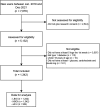Clinical performance of Hedia Diabetes Assistant bolus calculator for diabetes management: a real-world retrospective cohort study
- PMID: 40212899
- PMCID: PMC11983442
- DOI: 10.3389/fdgth.2025.1430744
Clinical performance of Hedia Diabetes Assistant bolus calculator for diabetes management: a real-world retrospective cohort study
Abstract
Introduction: Individuals living with type 1 diabetes are at risk of long-term complications related to chronic hyperglycemia. Tight glycemic control is recommended but can increase the risk of iatrogenic hypoglycemia. Hedia Diabetes Assistant (HDA) is a bolus calculator that provides users with bolus insulin recommendations based on personalized settings. We aimed to investigate the effects of HDA on a known risk index of hypoglycemia.
Methods: New users from 2019 to 2021 were included if they fulfilled the following criteria: age ≥18 years, ≥5 logs/1st week of use, and ≥1 log for glucose, carbohydrate, and insulin. User data was extracted from the HDA database. The prespecified primary endpoint was change in the Low Blood Glucose Index (LBGI) after 12 weeks of use. Secondary endpoints were changes in the High Blood Glucose Index (HBGI) and eA1c. An exploratory endpoint was to maintain potential improvements in LBGI after 25 weeks. A repeated-measures mixed model with a log-transformation was used.
Results: A total of 1,342 users were included. The mean age was 43.4 years (SD 14.7) with 52.3% being female. After 12 weeks, LBGI significantly improved from 0.73 to 0.61 (17% decrease, P < 0.001) with no significant changes in HBGI, and eA1c. From week 12 to 25, LBGI decreased from 0.61 to 0.55 (10%, P = 0.107).
Conclusions: Users of HDA experienced statistically significant improvement in LBGI after 12 weeks with no changes in HBGI and eA1c, which was successfully maintained after 25 weeks. These results suggest a decreased risk of hypoglycemia when using HDA.
Keywords: bolus calculator; digital technologies; glycemic control; hypoglycemia; type 1 diabetes mellitus.
© 2025 Pedersen, Østerskov, Nielsen, Karagkounis and Knudsen.
Conflict of interest statement
KP, GK and AK are employed at Hedia ApS. AØ is a former employee at Hedia ApS. SN is affiliated with Hedia ApS as a biostatistical consultant.
Figures


Similar articles
-
Carbohydrate counting with an automated bolus calculator helps to improve glycaemic control in children with type 1 diabetes using multiple daily injection therapy: an 18-month observational study.Diabetes Res Clin Pract. 2014 Mar;103(3):388-94. doi: 10.1016/j.diabres.2013.12.026. Epub 2014 Jan 3. Diabetes Res Clin Pract. 2014. PMID: 24447811
-
Impact of Use Frequency of a Mobile Diabetes Management App on Blood Glucose Control: Evaluation Study.JMIR Mhealth Uhealth. 2019 Mar 7;7(3):e11933. doi: 10.2196/11933. JMIR Mhealth Uhealth. 2019. PMID: 30843865 Free PMC article.
-
Sensitivity of Traditional and Risk-Based Glycemic Variability Measures to the Effect of Glucose-Lowering Treatment in Type 2 Diabetes Mellitus.J Diabetes Sci Technol. 2015 Jun 15;9(6):1227-35. doi: 10.1177/1932296815587014. J Diabetes Sci Technol. 2015. PMID: 26078255 Free PMC article.
-
Personalized intensification of insulin therapy in type 2 diabetes - does a basal-bolus regimen suit all patients?Curr Med Res Opin. 2016 Aug;32(8):1425-34. doi: 10.1080/03007995.2016.1181051. Epub 2016 May 25. Curr Med Res Opin. 2016. PMID: 27126277 Review.
-
Sliding scale insulin for non-critically ill hospitalised adults with diabetes mellitus.Cochrane Database Syst Rev. 2018 Nov 29;11(11):CD011296. doi: 10.1002/14651858.CD011296.pub2. Cochrane Database Syst Rev. 2018. PMID: 30488948 Free PMC article.
References
-
- den Brok EJ, Svensson CH, Panagiotou M, van Greevenbroek MMJ, Mertens PR, Vazeou A, et al. The effect of bolus advisors on glycaemic parameters in adults with diabetes on intensive insulin therapy: a systematic review with meta-analysis. Diabetes Obes Metab. (2024) 26(5):1950–61. 10.1111/dom.15521 - DOI - PubMed
LinkOut - more resources
Full Text Sources

